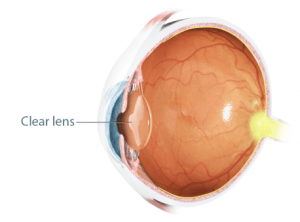Introduction
Refractive surgery is an ophthalmic surgical procedure useful in correcting refractive errors of the eye such as nearsightedness (myopia), farsightedness (hyperopia), astigmatism, and presbyopia. A successful refractive eye surgery provides clearer sharper vision, and can be an alternative to glasses or contact lenses.
Technique
Refractive surgery reshapes the transparent dome-shaped front part of the eye (cornea) and focuses the light traveling through the cornea to the retina situated in the back of the eye. Most of the vision correction surgeries work by reshaping the cornea, though some may require replacing the natural lens of the eye.
Refractive Eye Surgery – Types
There are different types of vision correction surgeries. Based on your eye examination, your eye doctor may recommend any of the following surgeries to improve your vision:
LASIK (Laser-Assisted In-Situ Keratomileusis) is a laser surgery useful in correcting vision abnormalities such as nearsightedness, farsightedness, and/or astigmatism. During a LASIK surgery, a flap is made in the outer layer of the cornea. This flap provides access to the underlying tissue of the cornea, which is reshaped in order to make the cornea focus light into the retina. Wavefront-guided treatments employ a more customised laser treatment to treat the specific irregularities of a patient’s eye.
PRK (Photorefractive Keratectomy) is a laser surgery useful in correcting mild to moderate nearsightedness, farsightedness, and/or astigmatism. During PRK surgery, an excimer laser is passed over the corneal surface to reshape the cornea. Wavefront Technology may also be used along with PRK.
Phakic Intraocular Lenses These implants are specifically designed to correct higher levels of nearsightedness. During phakic intraocular lens implantation, a small incision is made at the edge of the cornea. The implants are inserted through this incision and are then positioned in front of or behind the iris depending on your suitability.

RLE (Refractive Lens Exchange), also known as clear lens extraction, is a surgery to correct extreme farsightedness or nearsightedness. RLE is an appropriate surgery for patients with minor abnormalities of the cornea, dry eyes and for patients who are already presbyobic. During RLE, a small incision is created at the periphery of the cornea and the natural lens of the eye is replaced with an artificial lens.
PRELEX (Presbyopic Lens Exchange) is a corrective surgery for presbyopia. Presbyopia is caused due to the loss of elasticity of the eye’s lens resulting in reduced ability of the eye to focus on near objects. During PRELEX a multifocal lens is used to replace the natural lens of the eye. Since the natural lens of the eye is removed, patients will never develop cataracts in later life after a PRELEX surgery.
Intacs also known as intrastromal corneal rings or intracorneal rings is a procedure used to improve mild to moderate nearsightedness. During the Intacs procedure, a small incision is made on the cornea, and two crescent-shaped plastic rings are placed at the outer edge of the cornea. The embedding of the rings flattens the cornea and changes the focus of the light passing through the cornea to the retina. Today Intacs are mainly used for the treatment of irregular astigmatism, a condition that results in vision loss due to the irregularity in the shape of the cornea, known as keratoconus.
AK (Astigmatic Keratotomy) is a surgical procedure to correct astigmatism. During this procedure, the incisions are done at the steepest points of the cornea, and the cornea is reshaped from an oval shape to a more spherical shape.
Side Effects
As with any surgery, refractive eye surgery has its own set of side effects. Most of the side effects go away over time. Some of the possible side effects include:
- Infection
- Delayed healing
- Undercorrection or overcorrection
- Defective vision
- Excess corneal haze
- Halo effect, an optical effect that occurs in dim light, when pupil enlarges the untreated area on the outside of the cornea produces a second image
- Flap damage
- Regression
Conclusion
Most of the refractive eye surgeries are considered to be safe and effective. Refractive and laser eye surgeries usually are performed on healthy eyes that are free from other eye diseases. In order to be a good candidate for a refractive eye surgery it is important to understand the potential complications and have realistic expectations of the vision outcome.




